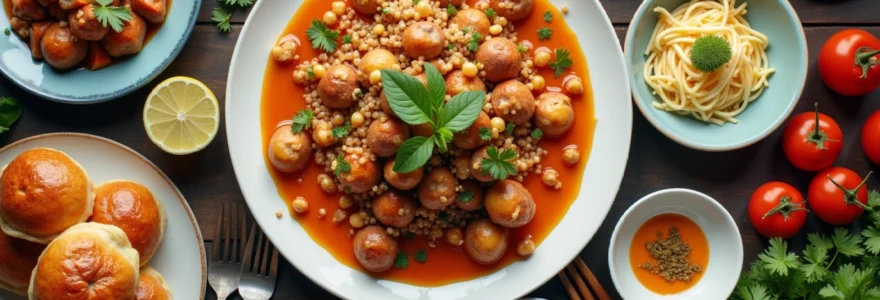Local cuisine serves as a vibrant mirror, reflecting the rich tapestry of a country’s culture, history, and identity. The flavours, ingredients, and cooking methods unique to a region offer profound insights into its people’s way of life, values, and traditions. From the spice-laden curries of India to the delicate sushi of Japan, each dish tells a story of its origins, migrations, and the ingenuity of those who created it. This exploration delves into the intricate relationship between food and culture, unravelling how local cuisines embody the essence of nations and communities worldwide.
Culinary anthropology: decoding cultural identity through local dishes
Culinary anthropology provides a fascinating lens through which to examine the cultural identity of a nation. By studying local dishes, anthropologists can uncover valuable information about a society’s history, social structures, and even its core values. The ingredients used, cooking techniques employed, and the rituals surrounding meal preparation and consumption all offer clues about a culture’s relationship with its environment, its economic conditions, and its social norms.
For instance, the prevalence of rice in many Asian cuisines reflects not only the region’s agricultural practices but also the importance of communal eating in these societies. The shared bowl of rice at the centre of the table symbolizes unity and family bonds. Similarly, the elaborate tea ceremonies in Japan are not merely about drinking tea but represent a deep-rooted cultural emphasis on mindfulness, respect, and harmony.
Culinary traditions often serve as a form of cultural preservation, especially in communities facing rapid modernization or external influences. By maintaining traditional recipes and cooking methods, people can keep their heritage alive and pass it down through generations. This is particularly evident in immigrant communities, where food becomes a powerful link to their ancestral roots and a means of maintaining cultural identity in a new land.
Gastronomic geography: regional ingredients and traditional cooking methods
The geography of a region plays a crucial role in shaping its cuisine. Climate, terrain, and available resources all contribute to the unique flavour profiles and cooking techniques that define local dishes. This intimate connection between land and plate creates a culinary landscape as diverse as the world’s topography.
Mediterranean diet: olive oil, fresh produce, and seafood in greek cuisine
Greek cuisine exemplifies the Mediterranean diet , renowned for its health benefits and delicious flavours. The abundance of olive groves in Greece has made olive oil a cornerstone of their cooking, used not only for its taste but also as a symbol of prosperity and peace. Fresh vegetables, legumes, and seafood feature prominently, reflecting the country’s coastal geography and fertile lands.
Traditional Greek dishes like moussaka and dolmades showcase the ingenious use of local ingredients, while the social custom of mezze – sharing small plates of food – highlights the importance of communal dining in Greek culture.
Nordic cuisine: foraging, fermentation, and preservation techniques
The harsh climate of the Nordic countries has given rise to unique culinary practices centred around preservation and maximizing limited resources. Foraging for wild berries, mushrooms, and herbs is deeply ingrained in Nordic food culture, connecting people directly with their natural environment.
Fermentation techniques, used to preserve food for long winters, have resulted in distinctive flavours like those found in Swedish surströmming (fermented herring) or Norwegian brunost (brown cheese). These methods not only extend the shelf life of food but also create complex flavour profiles that have become hallmarks of Nordic cuisine.
Spice routes: indian curry blends and their historical significance
Indian cuisine’s rich tapestry of flavours owes much to the country’s position along ancient spice routes. The diverse array of curry blends found across India tells a story of trade, conquest, and cultural exchange spanning millennia. Each region’s unique spice mix, or masala , reflects local tastes, available ingredients, and historical influences.
For example, the fiery vindaloo of Goa bears the imprint of Portuguese colonization, while the fragrant biryanis of Hyderabad speak to Mughal influences. These spice blends are not just flavouring agents but repositories of cultural memory and historical narratives.
Amazonian influence: indigenous ingredients in brazilian cookery
Brazilian cuisine showcases the profound impact of indigenous Amazonian ingredients on the country’s culinary identity. Foods like açaí, cassava, and heart of palm, long used by native communities, have become integral to Brazilian cooking and are now gaining global recognition.
The use of these ingredients in contemporary Brazilian dishes not only adds unique flavours but also serves as a reminder of the country’s rich biodiversity and the importance of preserving traditional knowledge. This fusion of indigenous ingredients with influences from European and African culinary traditions creates a truly unique gastronomic experience that embodies Brazil’s diverse cultural heritage.
Ritualistic gastronomy: food in religious and social ceremonies
Food plays a central role in religious and social ceremonies across cultures, often carrying deep symbolic meaning and reinforcing communal bonds. The preparation and consumption of certain dishes during specific events or holidays serve to connect people with their faith, history, and community.
Passover seder plate: symbolic foods in jewish tradition
The Passover Seder plate is a prime example of how food can embody religious significance. Each item on the plate – from the bitter herbs symbolizing the hardships of slavery to the charoset representing the mortar used by Jewish slaves in Egypt – tells a part of the Exodus story. The ritual of explaining these symbols during the Seder meal serves as an educational tool, passing down cultural and religious heritage to younger generations.
The Seder plate is not just a collection of foods, but a tangible representation of Jewish history and values, bringing ancient traditions to life on the modern table.
Día de los muertos: mexican ofrendas and pan de muerto
Mexico’s Day of the Dead celebrations beautifully illustrate how food can bridge the gap between the living and the deceased. Families create ofrendas (altars) adorned with the favourite foods and drinks of their departed loved ones. The special bread known as Pan de Muerto , decorated with bone-shaped pieces of dough, is both a culinary delight and a poignant reminder of the cycle of life and death.
This tradition not only honours the dead but also strengthens family bonds and community ties, as people come together to share memories and meals.
Lunar new year: symbolic dishes in chinese festive cuisine
The Lunar New Year, celebrated across many Asian cultures, is rich with culinary symbolism. In Chinese tradition, certain dishes are eaten for their auspicious meanings. For instance, dumplings shaped like ancient Chinese gold ingots represent wealth and prosperity, while long noodles symbolize longevity.
The preparation and sharing of these symbolic foods during family reunions reinforce cultural values and strengthen familial bonds. The act of eating together during this important festival is as much about nourishing the body as it is about nurturing relationships and cultural continuity.
Culinary diplomacy: national dishes as cultural ambassadors
National dishes serve as powerful cultural ambassadors, offering a taste of a country’s identity to the world. These iconic foods often become symbols of national pride and can play a significant role in shaping perceptions of a country abroad. Culinary diplomacy, or gastrodiplomacy, has become an increasingly recognized tool in international relations, with countries promoting their cuisine as a means of soft power.
For example, Thailand’s global promotion of its cuisine through the “Global Thai” program has not only boosted tourism but also enhanced the country’s cultural influence worldwide. Similarly, Japan’s efforts to have washoku (traditional Japanese cuisine) recognized by UNESCO as an Intangible Cultural Heritage have highlighted the country’s commitment to preserving its culinary traditions.
National dishes like Italy’s pizza, India’s butter chicken, or Argentina’s asado are more than just popular foods; they are cultural narratives that tell stories of a nation’s history, values, and way of life. When people around the world enjoy these dishes, they are, in essence, partaking in a form of cultural exchange, gaining insights into the country of origin through their taste buds.
Fusion cuisine: globalization’s impact on traditional food culture
Globalization has had a profound impact on culinary traditions worldwide, leading to the emergence of fusion cuisines that blend elements from different culinary cultures. This culinary cross-pollination reflects the increasingly interconnected nature of our world and the fluid nature of cultural identities in the modern era.
Tex-mex: the evolution of Mexican-American border cuisine
Tex-Mex cuisine is a prime example of how cultural interaction can create entirely new culinary traditions. Born from the blending of Mexican and American (particularly Texan) flavours and ingredients, Tex-Mex has evolved into a distinct cuisine with its own identity. Dishes like chili con carne and fajitas, while rooted in Mexican culinary traditions, have been adapted to suit American tastes and ingredient availability.
The story of Tex-Mex is one of cultural adaptation and innovation, reflecting the complex history of the U.S.-Mexico border region and the ongoing dialogue between two culinary traditions.
Indo-chinese: adaptation of chinese flavours in indian kitchens
Indo-Chinese cuisine represents a unique fusion that emerged from the Chinese community in Kolkata, India. This culinary style adapts Chinese cooking techniques and ingredients to suit Indian palates, resulting in dishes like Gobi Manchurian (cauliflower fritters in a spicy sauce) and Chilli Chicken, which have no direct counterparts in traditional Chinese cuisine.
The popularity of Indo-Chinese food across India demonstrates how culinary traditions can evolve and find new expressions when cultures intersect. It also highlights the adaptability of cuisine and its power to create new cultural identities.
California roll: japanese culinary influence in american sushi
The California Roll, with its use of avocado and imitation crab, represents a significant adaptation of traditional Japanese sushi to American tastes and ingredients. Created in Los Angeles in the 1960s, this roll helped popularize sushi in the United States by offering a more approachable version of the Japanese staple.
The success of the California Roll paved the way for further innovations in American sushi, leading to a diverse array of fusion rolls that blend Japanese techniques with local ingredients and flavours. This evolution demonstrates how traditional cuisines can be reimagined to suit new cultural contexts while still maintaining a connection to their roots.
Gastronomic heritage: UNESCO’s intangible cultural heritage and local cuisines
The recognition of culinary traditions as part of UNESCO’s Intangible Cultural Heritage of Humanity underscores the global understanding of food’s importance in cultural identity. This prestigious list includes not just specific dishes but entire culinary cultures and food-related practices that are considered valuable to humanity’s shared heritage.
Inclusions such as the Mediterranean diet, traditional Mexican cuisine, and the gastronomic meal of the French highlight the holistic nature of food culture. These recognitions encompass not just the food itself but the social practices, rituals, and knowledge associated with its preparation and consumption.
For instance, the inclusion of Belgian beer culture in the list acknowledges the brewing techniques, drinking traditions, and the social role of beer in Belgian society. Similarly, the recognition of kimjang, the traditional process of making and sharing kimchi in Korea, emphasizes the communal aspects of food preparation and its role in strengthening social bonds.
UNESCO’s recognition of culinary heritage serves not only to preserve traditional foodways but also to promote cultural diversity and sustainable development in the face of globalization.
This global acknowledgment of food’s cultural significance encourages countries to safeguard their culinary traditions while also fostering a greater appreciation for diverse food cultures worldwide. It reinforces the idea that local cuisines are not just about sustenance but are integral components of cultural identity, deserving of respect, preservation, and celebration.
As we continue to navigate an increasingly globalized world, understanding and appreciating the cultural significance of local cuisines becomes ever more important. Food serves as a universal language, capable of bridging divides and fostering cross-cultural understanding. By exploring the rich tapestry of global culinary traditions, we gain invaluable insights into the diverse cultures that make up our world, one dish at a time.


